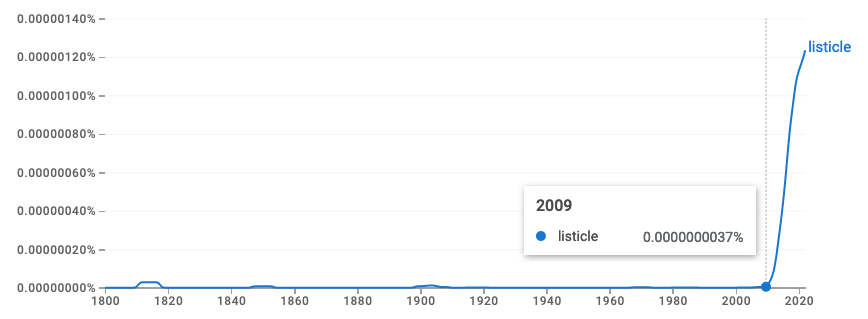What Is a Listicle?
The definition, description, types, examples and history of the popular phenomenon of online journalism — the listicle.

A Little About the Traditions of the “So List” Blog
Does this blog have any traditions? Perhaps. Here are some of them:
- Exploring the origins of the words used and not finding them.
- Delving deeper into questions than famous world dictionaries.
- Uncovering humorous historical typos and sharing stories about them.
- Starting a section with a list in an article using the phrase “So, the List”.
This blog post about the concept of a “listicle” will attempt to honor all four traditions.
What is a Listicle?
It allows authors to present information in a highly structured manner. The term “listicle” combines the words “list” and “article”. A post written in the listicle format is also referred to as a list post.
Listicles are often used in content marketing to engage readers and drive traffic to websites. Therefore, you wouldn't typically expect academic articles to be listicles. Some listicles appeal to readers' emotions, while others provide comparisons or present step-by-step guides. There are various formats.
Think of listicles as easily digestible content for regular readers.
Due to their structured format, listicles tend to enhance engagement and visibility in search results, attracting clicks and shares — particularly when the headlines start with numbers.
You can usually identify the listicle nature of a post from its title. Here are some examples of real-world listicle titles:
- 15 Best Woodworking YouTube Channels You Didn’t Know You Needed.
- 14 Best Guitar VST Plugins (Free and Paid) in 2024.
- Every 2025 Color of the Year That’s Been Announced So Far.
Topics that are similar or related to the ones below can also transform into listicles:
- 7 Ways to Save Money When You Visit Jupiter.
- 3 Approaches to Run From a Dinosaur: The Time Traveler’s Guide.
Listicles can also simplify complex topics to clarify intricate ideas. For instance, one of the listicles on this blog describes animals once thought to be extinct that have turned out not to be.
When and Where Did Listicles Appear?
The question of when humanity invented the popular format known as the listicle is complex. According to blogging tradition, the term “listicle” was first used as if it had always existed.
The Oxford English Dictionary states that listicles first appeared in 2007 [1]. However, earlier examples exist, as noted by the “A Way with Words” portal, which cites some listicle examples from 2001 [2].
Thanks to the Internet Archive, frequently praised in this blog, we can confirm that the earliest discovered mention of the word “listicle” was on July 14, 2001 [3]. It appeared in the following context:
7/14/01 - UPDATE - A page with people photos is now up! Also, added an article to the listicle to the lists section. Also, added many Maggie photos!
This discovery honors the second tradition of the blog.
The rise of digital content in the early 2000s played a significant role in the popularity of listicles.
Interestingly, Google Ngram Viewer indicates that the use of the term “listicle” began to rise in the late 2000s.

The graph shows spikes in usage even in the 19th century, which turned out to be scanning errors in old texts.
While the phenomenon of listicles undoubtedly existed before the term itself, many of the books of lists often referenced in this blog serve as excellent examples of high-quality listicles. Not all lists in these books qualify as valuable content, but they represent one of humanity’s greatest collections of well-written listicles.
Initially, the list format articles were mentioned only in posts and articles. The term “listicle” began appearing in books in the 2010s, confirming the existence of the phenomenon, with one notable exception.
In the book “Collections of the State Historical Society of North Dakota,” a person named Charles Lesticle is mentioned [4]. However, the index of the same book refers to him with a typo as Charles Listicle.
How to Pick a Title for a Listicle
Titling Listicles Designed for Search Engines
A well-crafted listicle features a clear and engaging title that accurately reflects the article's content and tone. Optimizing your listicle for search engines is crucial in making it easy for readers to find and engage with the material, thereby enhancing user interaction.
This involves conducting keyword research to understand the language used by the target audience when searching for information on a specific topic. Additionally, it’s important to grasp the search intent behind these queries.
This process results in a list of relevant keywords that search engine crawlers can easily identify, improving the article’s visibility and ranking. A listicle optimized for SEO not only attracts clicks but also sets the stage for informative and engaging content that follows.
The Power of a Catchy Title
For instance, a title like “7 Essential SEO Tips for Boosting Your Dalmatian Lover’s Blog Traffic” clearly indicates what the reader can expect while promising valuable insights.
A catchy title is descriptive and attention-grabbing, instantly drawing potential readers in. It acts as the first impression of your listicle, enticing readers to click and explore further.
Crafting such titles involves creativity and understanding of what resonates with your audience, ensuring that your listicle not only stands out but also delivers on the promise of valuable information.
So, the List of Types of Listicles. The Content Format Depends on the Original List Format
Interestingly, several types of listicles have already been identified in this relatively new concept. Understanding these different types can aid in developing an effective content strategy. The internet outlines three main kinds of listicles [5]:
- Ranked,
- Thematic,
- Random Order.
Ranked Listicles
The first type is based on a numbered list. For instance, an article titled “500 Greatest Songs of All Time According to Rolling Stones Magazine” is a ranked listicle. Similarly, “The Best Hotels in Canada for Your Next Vacation” falls into this category.
What makes the first example ranked is the relationship between the list items. For example, the song ranked #1 is considered by the authors to be better than the song at #2, and #300 is deemed better than #500. Typically, however, listicles are not that extensive.
Thematic Listicles
This type is structured around a hierarchical list. The content is defined by a general theme, which is then subdivided into subsections.
For example, here’s a hierarchical list that could serve as the basis for a popular topic text with multiple paragraphs of description. You can even continue the topic with several more list posts to provide in-depth information on each item.
Where to go for the weekend:
- Nature
- Forest
- Pond
- Mountain
- Sports Entertainment
- Football
- Table Tennis
- Kiting
- Concerts
- Rock
- Pop
- Classical
From this framework, you can write a simple listicle outlining various weekend entertainment options. The clear structure benefits both the author and the readers, especially when accompanied by visually appealing photos.
We will not delve into the details of these valuable items here, as that information is readily available from other resources.
Random Order Listicles
This type of listicle is characterized by an unordered list. For example, the list “10 Rules for Living by Winnie-the-Pooh” does not adhere to a strict order. Whether you start with “Always have a big barrel of honey” or any other item, the reader's attention is unlikely to wane.
The Structure in Listicle Format
It is important to note that the key element in organizing each of the types mentioned above is the specific list format used. The structure of the listicles form relies heavily on this choice. Thus, if you devise a new kind of list, you can create a fresh approach to writing listicles.
Effective content creation involves selecting the appropriate list type and organizing the content accordingly.
As a general rule, whether dealing with simple tips or complex topics, choose the appropriate list type, specify the number of points, and build your content around them. The list format ultimately dictates how the content is structured.
Where to Use Listicles
Listicles enhance engagement and improve visibility in search results due to their structured format, which often attracts clicks and shares, particularly when headlines feature numbers.
These articles come in various forms, each serving different purposes. Below are some common scenarios for using listicles, along with their unique styles and functions.
Entertaining Listicles
Entertaining listicles, such as “500 Greatest Songs…” or “10 Rules…”, aim to amuse readers.
A prime example is the BuzzFeed website, which publishes numerous entertaining list posts daily. BuzzFeed-style listicles often feature attention-grabbing titles and prioritize humor and readability over in-depth information.
Travel and Leisure Listicles
Travel and leisure listicles, like “10 Best Attractions in Istanbul” or “5 Fun Games When There’s No Internet”, help organize potential activities or destinations. These articles serve as quick guides for planning outings.
Instructional Listicles
Instructional listicles provide step-by-step guidance for accomplishing specific tasks. They include actionable steps that readers can follow to achieve their goals and are often based on top of operational definitions.
Content Marketing Listicles
List article is an effective tool for content marketing strategies, and some bloggers generate significant profits from them. These listicles can be extensive, offering in-depth information on complex topics, especially those intended to drive traffic for subsequent purchases of goods or services.
Affiliate Marketing Listicles
An example of an affiliate marketing listicle is “The Best Podcast Microphones for All Abilities and Budgets”. Often referred to as “ultimate guides”, these posts aim to inform readers and direct customer demand toward satisfaction.
The page is optimized for search engines with core and secondary keywords, and it contains affiliate links, allowing bloggers to earn a commission when customers make purchases through them.
Time to Write a Listicle
A listicle is essentially a list that has evolved into an article. Lists come in various forms, and so do the resulting writings. Listicles not only entertain and guide us but also play a crucial role in today’s internet economy as a key component of marketing content strategies.
The listicle format surpasses traditional articles by allowing readers to quickly scan and absorb significant information at a glance. This is made possible by the predictable structure of most listicles, making them easier to digest. Additionally, writing a listicle is often a straightforward task, as a well-crafted list provides a solid foundation to build upon.
Today, listicles are not limited to blog posts or articles; they can even be found in book form.
Possibly, we even call them “listooks” if following the already used schema.

Did you enjoy reading about how bullet points convert to different formats of a text and make listicles work? Subscribe to the “So List” blog and discover more about the forms lists and checklists take. You'll be amazed at their variety!
List of Links
[1] Listicle from the Oxford English Dictionary
[2] Listicle from A Way with Words
[3] Archived Page of My Comments and News from John Davin’s Website
[4] Collections of the State Historical Society of North Dakota from the Internet Archive
[5] “Listicle” from Wikipedia



